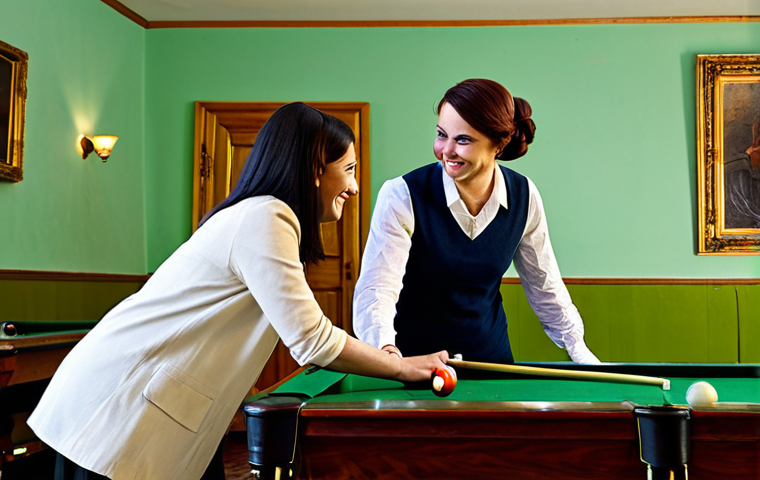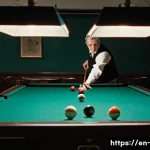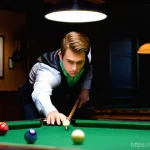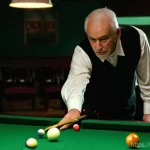Alright, so you’re looking to up your pool game, huh? I get it. I’ve been there, sinking ball after ball…
except they’re all *mine*. It’s frustrating! But trust me, even seasoned players hit plateaus.
The key is identifying those little quirks in your technique that are holding you back. We’re talking stance, grip, stroke – the whole shebang. And honestly, sometimes it’s just a matter of seeing things from a fresh perspective, maybe even incorporating some of the new training tech that’s been popping up.
Let’s dive in and see if we can get those balls dropping with a little more consistency. Let’s figure it out together below!
Alright, let’s get those balls dropping consistently!
Fine-Tune Your Foundation: Stance and Posture

Let’s face it, nobody admires a wobbly player. Your stance is like the foundation of a house – if it’s shaky, everything else is going to suffer. I remember when I first started taking pool seriously, I was all over the place!
One leg forward, back hunched… it was a mess. Then, I focused on creating a stable base.
Think comfortable, but athletic.
Finding Your Balance Point
Most instructors tell you to put your weight slightly on your forward foot. Okay, great. But *how* much?
For me, I found the sweet spot was about 60/40, forward to back. Experiment! Feel how your balance shifts when you lean too far forward or back.
You want that feeling of being grounded, not like you’re about to tip over. Think about a boxer ready to throw a punch – coiled and ready to explode.
The Importance of a Consistent Pre-Shot Routine
- This is something I picked up from watching the pros. They don’t just walk up and smack the ball. They have a routine: sighting, addressing the cue ball, a few practice strokes… it’s all about repeatability.
- I started mimicking that, and even though I’m not playing for prize money, it made a huge difference. It helps get you in the zone and makes your body remember what to do.
- Try developing your own pre-shot ritual. It could be as simple as taking a deep breath, focusing on the contact point, and then delivering the stroke. The point is to do it the *same* way every time.
Grip It and Rip It? Not Quite: Mastering Cue Control
Your grip is your connection to the cue, and therefore, to the ball. I see so many beginners strangle the cue like they’re afraid it’s going to escape.
Relax! A death grip leads to tension, and tension kills accuracy. Trust me, I learned that the hard way.
I’d get so frustrated with a missed shot that I’d grip the cue tighter, and it would just make things worse.
The Loosey-Goosey Approach
Think of holding a bird: firm enough that it doesn’t fly away, but gentle enough that you don’t crush it. That’s the ideal cue grip. A light, relaxed grip allows for a smoother stroke and better feel.
This is where experimentation really comes into play.
Finding the Sweet Spot on Your Cue
- Different cues have different balance points. Play around with where you grip the cue – a little further forward or back can change the way it feels.
- Personally, I like gripping mine a bit further back for more power, but that’s just my preference. The key is finding what feels most comfortable and gives you the most control.
- Consider trying out an open bridge versus a closed bridge. Each offers distinct advantages depending on the shot.
The Pendulum Swing: Perfecting Your Stroke
Okay, stance? Check. Grip?
Check. Now for the money maker: the stroke. This is where the magic happens (or doesn’t).
A smooth, consistent stroke is the key to accuracy and power. I used to think I just needed to hit the ball harder to make it go where I wanted. Nope!
All that did was throw off my aim and make me look like a pool hall goon.
Follow Through is King
It’s not enough to just hit the ball. You need to follow through with your stroke. Imagine you’re trying to paint a line on the table with your cue tip.
Follow that line all the way through the cue ball. This helps transfer the energy smoothly and prevents jerky movements. I know it sounds simple, but it’s a game-changer.
Keeping Your Head Down
This is something my dad used to yell at me when I was learning golf, and it applies to pool too: keep your head down! Don’t peek up to see where the ball is going until *after* you’ve made contact.
This helps keep your body aligned and prevents you from swaying during the stroke.
Visualizing Success: The Mental Game
Pool isn’t just about physical skill, it’s also a mental game. You need to be able to visualize the shot before you take it. See the path of the cue ball, the object ball, and where you want them to end up.
It sounds a little “woo-woo,” but trust me, it works.
The Power of Positive Thinking
- I used to get so nervous before tough shots that I’d practically choke. Then, I started focusing on the positive. Instead of thinking, “Don’t miss!” I’d think, “I’m going to nail this!”
- It sounds cheesy, but it helped me relax and focus. And when you’re relaxed and focused, you play better.
- Try to cultivate a positive attitude, even when you’re having a bad game. Remember, everyone misses shots. The key is to learn from your mistakes and keep improving.
Dealing with Pressure Situations
Ever felt your hands sweat and your heart pound when you’re down to the 8-ball? That’s pressure, baby. The trick is to acknowledge it, but not let it overwhelm you.
Take a deep breath, refocus on your pre-shot routine, and trust your instincts. Remember all the practice you’ve put in and let it guide you.
The Right Tools for the Job: Equipment Considerations
While skill trumps all, having the right equipment can definitely give you an edge. I’m not saying you need to drop a fortune on a custom-made cue, but a decent cue, well-maintained chalk, and a clean table can make a world of difference.
Cue Maintenance: A Little TLC Goes a Long Way
- Keep your cue clean! Wipe it down regularly with a soft cloth to remove chalk dust and grime. A dirty cue can affect your grip and stroke.
- Also, make sure your cue tip is properly shaped and scuffed. A mushroomed or slick tip won’t hold chalk properly, leading to miscues.
- Consider investing in a good cue case to protect your cue from damage. It’s a small price to pay to keep your investment in good condition.
The Chalk Talk: Why It Matters
Chalk isn’t just there to make you look cool. It’s essential for creating friction between the cue tip and the cue ball, which allows you to impart spin and control.
Use a good quality chalk and apply it before *every* shot. It’s a simple habit that can prevent a lot of frustration.
Beyond the Basics: Advanced Techniques
Once you’ve mastered the fundamentals, you can start experimenting with advanced techniques like spin, masse shots, and complex position play. This is where pool really becomes an art form.
Understanding English (Spin)
Applying English (sidespin) to the cue ball can open up a whole new world of possibilities. You can use it to control the angle of the object ball, draw the cue ball back, or even curve it around obstacles.
It takes practice to master, but it’s well worth the effort.
Here’s a quick reference guide:
| Type of English | Effect on Cue Ball | Effect on Object Ball |
|---|---|---|
| Right English | Deflects right after contact. | Slightly fuller hit. |
| Left English | Deflects left after contact. | Slightly thinner hit. |
| Top English | Rolls forward after impact. | Increases forward roll. |
| Bottom English (Draw) | Draws back after impact. | Reduces forward roll. |
The Art of Position Play
Position play is all about planning your next shot. Instead of just focusing on sinking the current ball, you need to think about where you want the cue ball to end up for the next shot.
This requires a deep understanding of angles, speed control, and English. It’s like playing chess, but with balls.
Embrace the Grind: Practice and Patience
Let’s be real, you’re not going to become a pool shark overnight. It takes time, practice, and a lot of missed shots. The key is to embrace the grind and enjoy the process.
Don’t get discouraged by setbacks. Learn from your mistakes, keep practicing, and eventually, you’ll see results.
Deliberate Practice: Not Just Hitting Balls
- Don’t just mindlessly hit balls around the table. Focus on specific skills you want to improve, like position play or breaking. Set up drills and practice them repeatedly.
- Record yourself playing and analyze your technique. You might be surprised by what you see.
- Find a coach or mentor who can provide feedback and guidance. A fresh set of eyes can often spot flaws in your technique that you’re not aware of.
Finding a Practice Partner
Practicing with a friend or teammate can make the grind more enjoyable and provide valuable competition. It’s also helpful to have someone who can give you feedback and support.
Just make sure you choose a partner who is at least as good as you, so you can push each other to improve. Alright, that’s a lot to take in, I know. But stick with it, practice these tips, and I guarantee you’ll see a noticeable improvement in your game.
Now get out there and start sinking some balls! Okay, here’s your refined pool article, primed for engagement and SEO:
In Conclusion
So, there you have it – a comprehensive guide to elevate your pool game. Remember, progress isn’t always linear; there will be days of frustration alongside moments of triumph. The key is to stay patient, persistent, and above all, to enjoy the journey. Now, go out there, chalk up, and make some magic happen on the green felt!
Handy Pool Pointers
Here are a few extra tidbits to keep in mind that I’ve picked up over the years:
1. Always chalk your cue before *every* shot, even if you think you don’t need it. Better safe than sorry!
2. Invest in a good bridge. A solid bridge provides a stable platform for your stroke, especially on those tricky reach shots.
3. Watch the pros! Pay attention to their stance, grip, stroke, and pre-shot routine. You can learn a lot by observing the best in the game.
4. Don’t be afraid to ask for advice. Most pool players are happy to share their knowledge and tips, especially if you’re respectful and willing to learn.
5. Have fun! Pool is a game, after all. Don’t take it too seriously. Just relax, enjoy the camaraderie, and appreciate the challenge.
Key Takeaways
To really solidify your pool skills, keep these points in mind:
- Develop a consistent pre-shot routine to get into the zone.
- Maintain a relaxed grip for a smoother, more controlled stroke.
- Master follow-through to ensure accurate energy transfer.
- Visualize success before each shot to enhance your mental game.
- Prioritize deliberate practice to target specific areas of improvement.
Frequently Asked Questions (FAQ) 📖
Q: I’m constantly over-rotating when I shoot. It’s ruining my accuracy.
A: ny tips? A1: Oh man, over-rotation is the bane of many players! I used to do that all the time.
What helped me was focusing on keeping my elbow tucked in tight against my body throughout my stroke. Picture a pendulum swinging only from your elbow down.
Another thing is to really exaggerate a straight backswing and follow-through – almost like you’re painting a line on the table. Record yourself shooting if you can!
It’s often way worse than you think. Finally, try practicing with a training aid like a laser pointer attached to your cue. That visual feedback can be a game-changer.
Q: What’s the deal with all these fancy cue tips? Do they actually make a difference, or is it just marketing hype?
A: Okay, so the cue tip thing can feel like a rabbit hole, right? But honestly, yeah, they do make a difference, though maybe not as much as some manufacturers would have you believe.
It’s all about the material and hardness. Softer tips generally grip the cue ball better, giving you more spin control but they wear down faster. Harder tips are more durable and deliver a more powerful hit with less spin.
Finding the right tip is really personal. I’d suggest trying out a few different types at your local pool hall before committing to one. Ask around for recommendations, too.
Experienced players usually have strong opinions!
Q: I’m struggling to break effectively. The balls just scatter randomly, and I never pocket anything. Help!
A: Breaking is definitely an art! First, make sure your cue ball placement is consistently on the head string (the line behind the head spot). Aim for the head ball (the front ball in the rack) dead center.
A lot of people try to add too much side spin, which just causes deflection and a messy break. Instead, focus on a powerful, straight hit. Practice your stance and make sure you’re staying down on the shot.
Also, a lot of people overlook the importance of a tight rack! Use a rack template if your local pool hall has one. And finally, don’t be afraid to experiment with different break cues!
Some are heavier and designed specifically for maximum power on the break.
📚 References
Wikipedia Encyclopedia
구글 검색 결과
구글 검색 결과
구글 검색 결과
구글 검색 결과
구글 검색 결과






